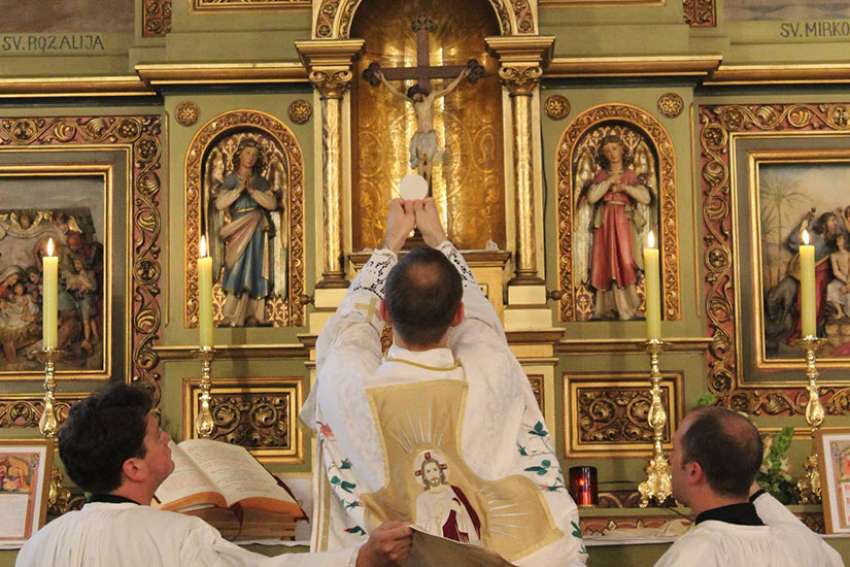“Sometimes there are these polemics, but I think Benedict tried to overcome these polemics, saying that even in the liturgy there is a certain progress … but clearly in full continuity with the tradition of the Church,” Fr. Vincenzo Nuara, OP, told CNA May 31.
Tensions were heightened after the Second Vatican Council's reforms, and “unfortunately these situations of contrast, of opposition are created” even today, Fr. Nuara said.
In light of this situation, Benedict XVI’s 2007 motu proprio Summorum Pontificum, which widened access to the pre-Vatican II liturgy, “was not an instrument to divide” or throw further fuel on the flames, he said.
“I see it as a positive instrument, not negative,” Fr. Nuara said. “It’s not an instrument for going backwards. It’s an instrument to reconnect ourselves in continuity” with different ecclesial styles.
Fr. Nuara is president of the association “Priestly Friends of Summorum Pontificum” and founder and spiritual assistant of the “Youth and Tradition” association.
He is also one of the organizers of an upcoming Sept. 14-17 pilgrimage marking the 10th anniversary of Summorum Pontificum.
The motu proprio was issued July 7, 2007, and went into effect Sept. 14 of that year, the feast of the Exaltation of the Cross.
The document established that the post-Vatican II Roman Missal, first issued by Blessed Paul VI, is the ordinary form of the Roman rite, and that the prior version, last issued by St. John XXIII in 1962 and known as the Traditional Latin Mass or the Tridentine Mass, is the Roman rite's extraordinary form.
In the motu proprio, Benedict noted that the Traditional Latin Mass was never abrogated. He awknowledged clearly the right of all priests of the Roman rite to say Mass using the Roman Missal of 1962, and established that parish priests should be willing say the extraordinary form for groups of the faithful who request it.
Benedict also established that the faithful could have recourse to their bishop or even the Vatican if their requests for celebration of the extraordinary form were not satisfied.
The provisions of Summorum Pontificum for the use of the extraordinary form replaced those of St. John Paul II laid down in Quattuor abhinc annos and Ecclesia Dei.
According to that indult, priests and faithful who wished to celebrate the Traditional Latin Mass had to get permission from their bishop to do so. It could only be for those who requested it, could not normally be said at parish churches, and the bishop could set days and conditions for its celebration.
After the Second Vatican Council, the Missal issued by Bl. Paul VI, also known as the Novus Ordo, was widely adopted. It was widely translated into vernacular languages, and is often celebrated with the priest facing toward the congregation.
However, not a few faithful continued to be attached to the earlier form of the liturgy, and Benedict's motu proprio was considered a generous response to these faithful.
Benedict wrote in the motu proprio that the two forms “will in no way lead to a division” in the Church's belief “for they are two usages of the one Roman rite.”
Fr. Nuara reflected that since Summorum Pontificum, “those who have permission to use the ancient form of the liturgy have also at the same time rediscovered the sanctity of the new.”
This mutual enrichment is a discovery Fr. Nuara said he himself has made in his 25 years as a priest, during which he has celebrated both the new and ancient liturgical formulas.
“Benedict is a positive man. Benedict, who reflects as a theologian and a pastor, realized that the ancient form that has grown in the history of the Church for years, can give new impetus to the new form,” he said.
The Mass “is the bridge where they meet, because the Eucharist is the point of encounter … the sacrament of unity,” Fr. Nuara said, adding that what “must be avoided” is that people “take advantage of their particular trend or attention to one or the other liturgy, to create fences of division and separation.”
Benedict himself celebrated the new form of the liturgy “with great dignity,” but before his election as Bishop of Rome was also known to celebrate the ancient liturgy with the same esteem.
What Summorum Pontificum seeks to do is to work for this unity, he said, adding that at 10 years since its publication, his hope is that people from both sides will work toward this goal.
“We want to send, to communicate this message,” he said. “Because the Church is a family, the family of God.”

